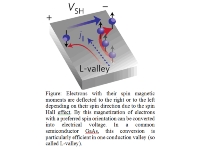Researchers from the Institute of Physics ASCR realize an efficient spin-charge converter
Current information technologies are either charge-based or spin-based. Semiconductor microprocessors are prime examples among the large variety of charge-based devices. They utilize the possibility offered by semiconductors to easily electrically manipulate and detect their electronic charge states representing the zeros and ones. Spin-based devices operate on an entirely distinct principle.
In some materials, like iron, electron spins spontaneously align their direction which
generates magnetism. The position of the north and the south pole of the magnet can be used to
represent the zeros and ones. This technology is behind memory applications such as computer hard
disks. Efficient spin-charge and charge-spin convertors are needed for future technologies allowing
to integrate the so far isolated worlds of semiconductor and magnetic devices.
Researchers from the Institute of Physics of the Academy of Sciences in Prague, in
collaboration with researchers from the UK, Germany, and Japan, have discovered and efficient
spin-charge converter in a common semiconductor material GaAs. The work has been published in the
journal
Nature Materials on August 10th, 2014 (DOI:
10.1038/nmat4059).
The device functionality is based on the relativistic phenomenon called the spin Hall effect
which the Czech-UK group discovered in 2004 and which since then has become a text-book tool for
converting electrical to magnetic signals, and vice versa, in a broad class of metals and
semiconductors. So far, the most efficient spin-charge converters have been identified among
heavy-metal elements such as platinum. Researchers from the Institute of Physics with their
international colleagues found that one of the most common semiconductors GaAs can be turned into
an as efficient spin Hall effect spin-charge converter as platinum. They utilized the property of
semiconductors in which electrons can carry the current of their charge and spin in different
conduction “valleys”. Researchers discovered that by moving carriers in GaAs from one to another
valley, the spin-charge conversion efficiency increases in this semiconductor forty-times.
For detail information contact Tomas Jungwirth from the Institute of Physics AVCR, v.v.i.,
Cukrovarnická 10, 162 53 Praha 6, e-mail:
jungw@fzu.cz
20 Aug 2014







Because Katareeya originates from a “third country”, namely, Australia, according to the Czech legislation she is not entitled to healthcare support from the public healthcare insurance.
More information...